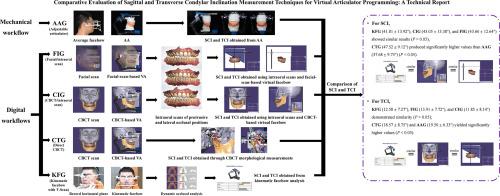虚拟关节器编程中矢状和横向髁倾角测量技术的比较:概念验证研究。
IF 5.5
2区 医学
Q1 DENTISTRY, ORAL SURGERY & MEDICINE
引用次数: 0
摘要
目的:本技术评估旨在比较5种测量矢状面(SCI)和横向髁倾角(TCI)的技术,以优化数字牙科中的虚拟关节器编程。方法:14名健康受试者(男7名,女7名,年龄18-25岁),28个颞下颌关节。基于自然头位(NHP)和水平面标记,开发了一种新的虚拟脸弓系统来评估5种测量方法:(1)可调节关节(AAG);(2)面部/口内扫描整合(FIG);(3) CBCT/口内扫描融合(CIG);(4)直接CBCT测量(CTG)和(5)运动脸弓与t扫描分析(KFG)。三次测量的咬合间、突出和外侧记录取平均值。统计分析包括双边比较的配对t检验和技术比较的重复测量方差分析,采用Bonferroni-Greenhouse-Geisser校正。结果:左、右髁倾角值差异无统计学意义(P < 0.05)。SCI和TCI值的测量技术之间存在显著差异(P < 0.001)。具体地说,对于SCI, KFG(41.81 ± 13.92°),是到岸价(43.05 ± 13.38°),和无花果(43.60 ± 12.64°)显示类似的结果(P > 0.05),而玻纤(47.52 ± 9.12°)值产生显著高于亚美大陆煤层气有限公司(37.68 ± 9.75°)(P < 0.05)。TCI, KFG(12.58 ± 7.27°),图(13.91 ± 7.72°),和是到岸价(11.85 ± 8.14°)再一次证明了相似(P > 0.05),而两个CTG(18.57 ± 8.75°)和亚美大陆煤层气有限公司(19.50 ± 6.33°)产生了更高的值(P < 0.05)。结论:基于自然头部位置和水平面标记的数字工作流程-整合面部,口内和锥形束计算机断层扫描数据-实现与动态脸弓记录相当的矢状和横向髁倾斜值,支持它们作为虚拟关节器编程的可靠替代方案。临床意义:基于自然头部位置的集成数字协议为髁突倾斜评估提供了高效、临床有效的解决方案,支持向数字化修复工作流程的过渡。本文章由计算机程序翻译,如有差异,请以英文原文为准。

Comparison of sagittal and transverse condylar inclination measurement techniques in virtual articulator programming: a technical report
Objectives
This technical evaluation aimed to compare 5 techniques for measuring sagittal (SCI) and transverse condylar inclination (TCI) to optimize virtual articulator programming in digital dentistry.
Methods
14 healthy participants (7 males, 7 females; aged 18–25 years) with 28 temporomandibular joints were evaluated. A novel virtual facebow system was developed to assess 5 measurement approaches based on natural head position (NHP) with horizontal plane markers: (1) Adjustable articulator (AAG); (2) Facial/intraoral scan integration (FIG); (3) CBCT/intraoral scan fusion (CIG); (4) Direct CBCT measurement (CTG), and (5) Kinematic facebow with T-Scan analysis (KFG). Triplicate measurements of interocclusal, protrusive, and lateral records were averaged. Statistical analysis included paired t-tests for bilateral comparisons and repeated measures ANOVA with Bonferroni-Greenhouse-Geisser corrections for technique comparisons.
Results
No significant differences were observed between left and right condylar inclination values (P > 0.05). Significant differences were detected among the measurement techniques for both SCI and TCI values (P < 0.001). Specifically, for SCI, KFG (41.81 ± 13.92°), CIG (43.05 ± 13.38°), and FIG (43.60 ± 12.64°) showed similar results (P > 0.05), while CTG (47.52 ± 9.12°) produced significantly higher values than AAG (37.68 ± 9.75°) (P < 0.05). For TCI, KFG (12.58 ± 7.27°), FIG (13.91 ± 7.72°), and CIG (11.85 ± 8.14°) again demonstrated similarity (P > 0.05), whereas both CTG (18.57 ± 8.75°) and AAG (19.50 ± 6.33°) yielded significantly higher values (P < 0.05).
Conclusions
Digital workflows based on natural head position with horizontal plane markers—integrating facial, intraoral, and cone beam computed tomography data—achieve sagittal and transverse condylar inclination values comparable to kinematic facebow recordings, supporting their use as reliable alternatives for virtual articulator programming.
Clinical significance
Integrated natural head position‑based digital protocols provide efficient, clinically valid solutions for condylar inclination assessment, supporting the transition to digital prosthodontic workflows.
求助全文
通过发布文献求助,成功后即可免费获取论文全文。
去求助
来源期刊

Journal of dentistry
医学-牙科与口腔外科
CiteScore
7.30
自引率
11.40%
发文量
349
审稿时长
35 days
期刊介绍:
The Journal of Dentistry has an open access mirror journal The Journal of Dentistry: X, sharing the same aims and scope, editorial team, submission system and rigorous peer review.
The Journal of Dentistry is the leading international dental journal within the field of Restorative Dentistry. Placing an emphasis on publishing novel and high-quality research papers, the Journal aims to influence the practice of dentistry at clinician, research, industry and policy-maker level on an international basis.
Topics covered include the management of dental disease, periodontology, endodontology, operative dentistry, fixed and removable prosthodontics, dental biomaterials science, long-term clinical trials including epidemiology and oral health, technology transfer of new scientific instrumentation or procedures, as well as clinically relevant oral biology and translational research.
The Journal of Dentistry will publish original scientific research papers including short communications. It is also interested in publishing review articles and leaders in themed areas which will be linked to new scientific research. Conference proceedings are also welcome and expressions of interest should be communicated to the Editor.
 求助内容:
求助内容: 应助结果提醒方式:
应助结果提醒方式:


